President's Message
Fellow woodworkers
What is the big attraction of woodworking? Is it the tools we can buy and enjoy using? Or is it being able to see the beautiful finished piece of work we have made? Or is it the challenge of working out how to make something?
I think for me the most interesting part of the process is the "how to" part. It is great to be able to obtain good tools and master how to use them. It is also very satisfying to look at a finished piece and admire what you have made – but the problem I have with this last part is I cannot just look and admire one of my finished pieces. My eyes always move straight to focusing on the flaws/errors and thinking how I can make the piece better next time.
But the "how to" is definitely the most interesting part. How to make a jig or a fixture that allows you to cut an odd angle or bore a hole in a strange place etc. My jigs are rough, they never look like well made pieces of joinery. I tend to experiment with different designs and adjustments until the jig lets me do what I was trying to achieve then it is put straight into use. It is interesting to design a jig to solve the problem but once the problem has been solved I never seem to have the time to go back and make a nice clean version of the jig.
About 5 years ago I started making batons for a friend's artworks. In order to drill the holes I needed in the batons I made a very rough Vee jig that I used to hold them on the drill table. Every few months since then I have had to make some more batons and every time I use the initial rough jig and tell myself I will make a better one for the next batch - which has not yet happened.
Woodcraft and Rockler are always coming out with new jigs but they mostly seem to solve the problems that I do not find a problem. The real jigs I need are one-off specials - inventing them and using them is one of the big joys of woodworking.
Last Saturday we saw some real one-off jigs in action when we visited Lou Kern in his workshop. Lou had given us his interesting presentation at the October meeting about how he made the complex stair rails and banisters for fine Victorian houses in the Bay Area. He had said it was all about geometry and on Saturday we saw geometry in action. Starting with a full scale MDF model of the stair section, Lou made a few "simple" jigs then, with a couple of bandsaws and a modified Dremel type router, he was able to make a section of twisting header rail for the staircase. The process is part geometry and part artistic eye. It was fascinating.
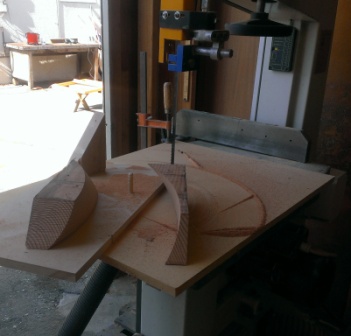
The bandsaw jig used to cut the compond curved angles
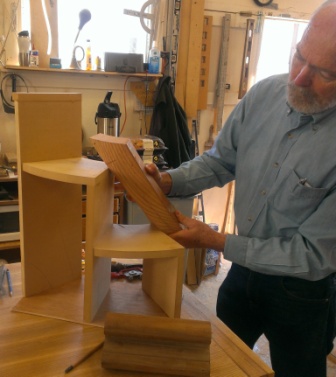
Checking the bandsawn block aligns with the full size model of the stairs
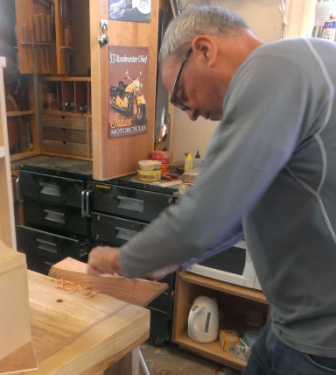
Spokeshaving the rail "square"
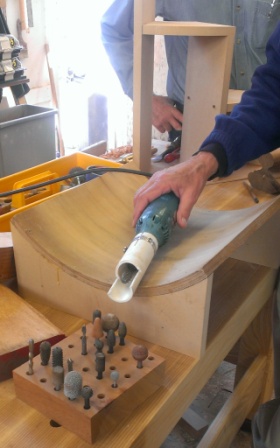
The adapted router and bits
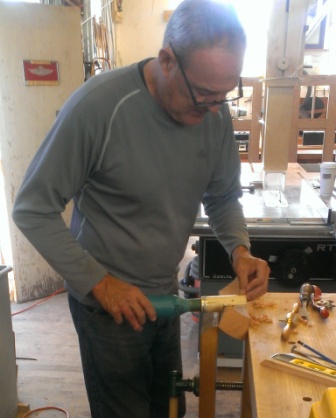
The final shaping of the handrail sides
Our meeting night in November is going to be a busy one. Prior to our normal meeting we have a Board of Directors meeting starting at 5.00pm. This meeting is open to all members. The agenda for this will be sent out shortly.
We start our regular meeting's social time at 6.30pm. Then at 7.00pm we have our, short, annual meeting where we elect our Directors for next year. The Board is defined in our ByLaws and consists of 7 members:
Present Incumbents
President: Frank R. Ramsay
Vice-President: Jay Perrine
Secretary: John Blackmore
Treasurer: Marcus Miller
Newsletter Editor: Steve Rosenblum
Program Director: Per Madsen
Membership Director: Fred Reicher
Any current member is entitled to put his name forward as a possible candidate for the Board. Those of you who would like to do so should send your name and the position you are interested in to John Blackmore our secretary at: JohnBlackmore@comcast.net
Enjoy your woodworking
Frank [Contact at: frankramsay8@aol.com
Frank Ramsay called the meeting to order and proceeded immediately to announcements.
Announcements:
Per Madsen described the upcoming events and introduced Dan Goodman to talk about the workshop planned for Saturday and Sunday, Oct 19 & 20 at Jamie Buxton's shop to construct cubby cabinets for the Woodrow Wilson Elementary School in Daly City. The workshop starts at 8am both days.
A Board meeting will precede the regular BAWA meeting on November 21. At the regular meeting officers will be elected for calendar year 2014. The speaker for the meeting will be Juan Hovey, an in-fill plane maker.
The December meeting will be held on the second Thursday, the 12th. It is the annual hors d' oeuvres pot luck celebration and will feature an expanded show and tell segment.
Neil White has donated a dial caliper to the silent auction. The high bid was submitted by Jay Perrine.
Harold Patterson will hold the first Toy Workshop on November 2 at Jamie's workshop in San Carlos. He needs wheel makers and is asking for volunteers. The workshop will start at the sane hour of 10am.
Stan Booker brought in a beautiful cherry board for the raffle, measuring 9 feet long, 14 inches wide. Tickets were selling at a blistering pace. Stan also showed us a piece of the now famous holy oak that he will be using to make a dining room table. He also brought in some carvings from his latest trip to East Africa and will show them at the break.
John R. Shelly, PhD.Extension Specialist, University of California Forest Products Laboratory.

The topic is Dr. Shelly's presentation tonight is "Understanding California Hardwoods." His focus will be on three facets of this topic: cell structure, wood properties and pests.
When looking at the interior zones of a tree it is important to understand that the juvenile wood occupies the central zone and extends the full length of the tree and represents the first 10 to 20 years of growth. Juvenile wood is subject to a high level of longitudinal shrinkage and therefore is not considered good for lumber. The best wood in the tree is low in the trunk, not high.
Reaction wood is that area of growth that responds to the forces of gravity, around branches for instance and is characterized by figured grain patterns.
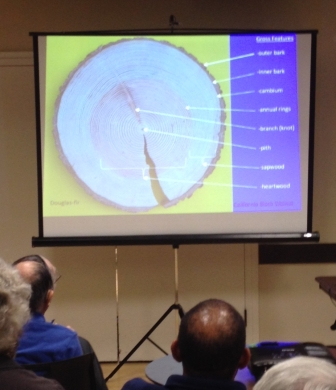
The bark layer of the tree has two layers: the outer bark, a protective layer on the outside of the tree, the cambium where the growth occurs. The sapwood is the tree's pipeline for moving water up to the leaves and is the new wood. The heartwood is the central supporting pillar of the tree. Although considered dead wood, it is nevertheless strong and supports the tree. The growth rings of the tree contain early and late wood, early being the fast growth wood created early in the growing season. As you look at a cross section of a cut tree, you will notice that the pith or core of the tree is off center. It is thicker on the compression side of the tree that is subject to the forces of weather or gravity. It is weaker, more flexible wood.
Lumber cut on a tangent to the growth rings will have twice as much shrinkage and expansion as radially cut wood. Quarter sawn wood is radially cut.
The cellular structure of hardwoods is more specialized than that found in softwoods.
Several hardwoods are plentiful in California and include black oak, madrone, walnut, Modesto ash and red gum eucalyptus. Blue gum eucalyptus, an import from Australia with the other varieties of eucalyptus, is a poor lumber wood; although the red gum can be a fine and dense wood if processed properly. The workability of wood depends on its cell structure, finer cell structure being more desirable.
Water in Wood
Free water in wood occupies the cell lumens, voids and rests on the surface of the wood. Bound water exists only in the cell walls. Generally there is about 25-28% bound water to reach the Equilibrium Water Content (EWC) or fiber saturation point for wood. When water is removed below the EWC, things begin to change and the wood changes shape. EWC is more influenced by water in the air than by temperature. Dr. Shelly recommends using pin type moisture meters since they are more accurate than the surface measuring plate devices. Wood can be case hardened if too much water is removed during drying. When cut, this case hardened wood will move and distort in shape, frequently bowing. To prevent case hardening, it is necessary to add water back into the wood.
Several wood drying techniques are available from stickered stacking for air drying, kiln drying, dehumidifying and solar driers.
Pests can be classified as wet or dry wood infesters. Dry wood pests are of more concern to woodworkers and include round head worms, flat head worms and powder post beetles, the biggest nemesis for the woodworker. Also known as lyctids, these beetles can be killed by heating the wood to over 140 degrees F for at least 6 hours, by fumigation and even by freezing. John showed us a segment from a wooden fishing net frame that had been crafted in madrone. When scooping up a fly caught fish, the owner was surprised to see it disintegrate in his hand. It had been thoroughly pulverized inside its core by powder post beetles.
John Shelly kindly left several samples of the California hardwoods for the BAWA members to take home. He will post his excellent presentation on his website for reference. Thank you John for a very informative presentation.
For a full copy of John's presentation go to: ucanr.edu/sites/WoodyBiomass/newsletters/Hardwood_Information49229.pdf
You can find information by the University of California on Hardwood Utilization at: ucanr.edu/sites/WoodyBiomass/HardwoodUtilization
The entries into the contest were remarkable this year. Truly fine woodworking with a flair for imagination and execution.
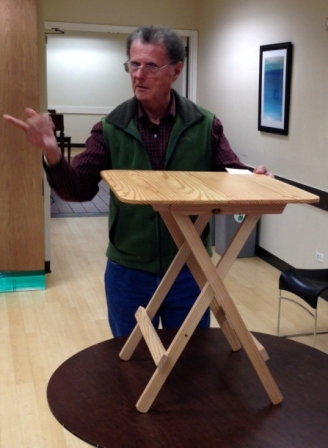
John Wilson-a folding table built from plans provided by Lee Valley

Jamie Buxton-a triangular legged chair with mortise and tenon joints and bent lamination back legs. Jamie Buxton-also showed a tray/breadbasket
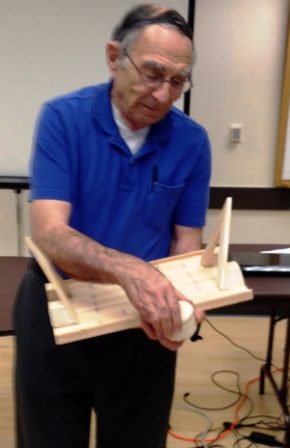
Mark Rand-a tray with pyramid shaped handles and end grain inserts for contrast
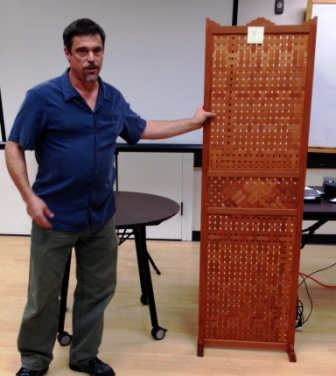
Claude Godcharles-a woven lattice screen made of redwood. The woven lattice strips are 332 inch thick. He used a window pane router bit
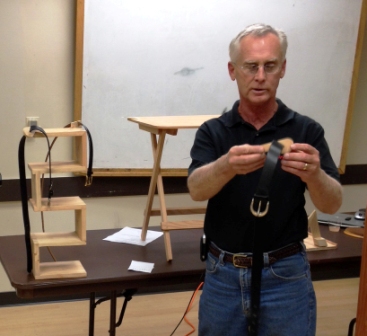
Ken Napior-a laddered series of connected boxes made with different joints and used as a tower to hang belts using a clever balancing hook
Bruce Powell-trays
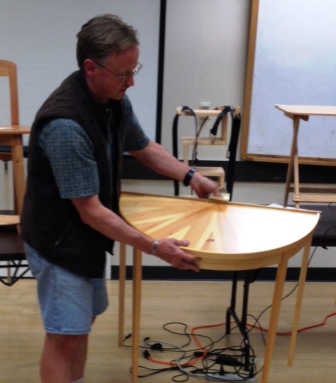
Tom Gaston-a demi Lune table with four legs captured in a mortise/tenon structure within the apron of the table. The radial pattern on the tabletop is assembled from book matched 22 1/2 degree sections. The curved apron was made using a wet 2 x 4 from Home Depot. A dry wood attempt had fractured. Only a slight rules infraction
And the awards went to everyone:
Claude, most intricate
Mark, most wacky
Jamie, most useful
Tom, most beautiful
John, open category
Ken, open category
Bruce, open category
Nice job everyone.
John Blackmore, Secretary
JohnBlackmore@compactness